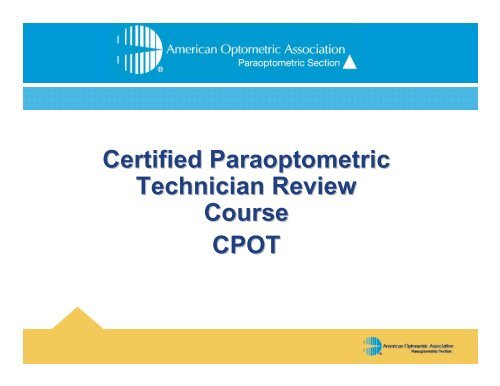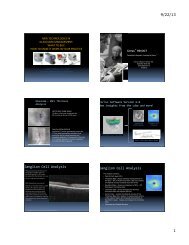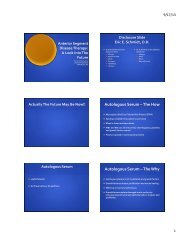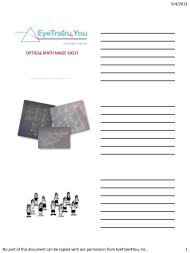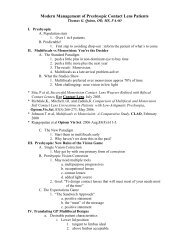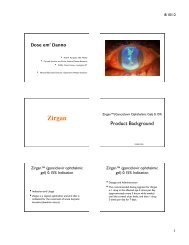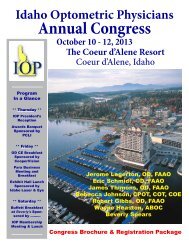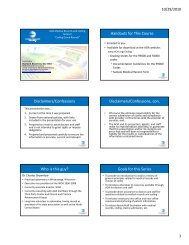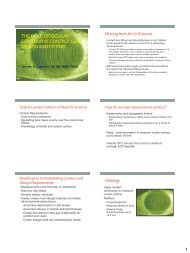Certified Paraoptometric Technician Review Course CPOT - Idaho ...
Certified Paraoptometric Technician Review Course CPOT - Idaho ...
Certified Paraoptometric Technician Review Course CPOT - Idaho ...
Create successful ePaper yourself
Turn your PDF publications into a flip-book with our unique Google optimized e-Paper software.
<strong>Certified</strong> <strong>Paraoptometric</strong><strong>Technician</strong> <strong>Review</strong><strong>Course</strong><strong>CPOT</strong>
ProvisionThe Self Study <strong>Course</strong> for <strong>Paraoptometric</strong> Assistants and<strong>Technician</strong>s, Self Assessment Examination, and the AOA PS <strong>CPOT</strong><strong>Review</strong> <strong>Course</strong> are not prerequisites for taking the paraoptometriccertification examination given by the Commission on<strong>Paraoptometric</strong> Certification (CPC). Using these study materialsand/or taking the <strong>CPOT</strong> <strong>Review</strong> course does not guarantee passingthe paraoptometric certification examination given by the CPC.Attending the <strong>CPOT</strong> <strong>Review</strong> <strong>Course</strong> is not a substitute for studyingfor the paraoptometric certification examination given by the CPC.This course is designed to review previously acquired knowledge.
This review course is not intended to be a substitute for responsiblestudy and preparation for the <strong>CPOT</strong> test.
Outline•Pre-Testing Procedures (20%)•Clinical Procedures (28%)•Ophthalmic Optics and Dispensing (20%)•Refractive Status of the Eye and Binocularity (12%)•Anatomy and Physiology (15%)•Practice Management (5%)April 16, 2009<strong>Paraoptometric</strong> Section Branding Project
Pre-Testing Procedures(20%)
Case HistoryComponents• Chief complaint• Medical and ocular history• Patient• Family• Occupation and avocation• HIPAA
Visual AcuityTypes and charts• Snellen• Feinbloom (Low Vision)• Pre-school and Illiterate• Allen picture cards• Tumbling E’s• HOTVCourtesy of Richmond ProductsCourtesy of NEI
ProcedureDistance w/out RXNear w/out RXDistance with RXNear with RXOr a variation of the aboveCourtesy of Richmond Products
ProcedurePatient unable to see the big “E”• Count Fingers- CF @ _____ft• Hand Motion- HM @______ft• Light Projection• Light PerceptionCourtesy of Richmond Products
ProcedureAmblyopia• Single line presentation• Single letter presentation• Low Vision• Feinbloom Low Vision Chart
PinholeTo determine if reductionin vision is dueto refractive error
ProcedureAlways observe patient.No squinting. Why?When do you obtain pinhole acuity?Visual acuity better with one eye or two?Note any consistent pattern in the lettersmissed by the patient. Why?
ConversionFeetMeters20/20 6/620/25 6/720/30 6/920/40 6/1220/60 6/1820/80 6/2420/100 6/3020/200 6/6020/300 6/9020/400 6/120
ConversionFeet to metersMultiply the denominator by .3Meters to feet• Divide the denominator by 3• Add a zero
Visual SkillsTelebinocular
Interpupillary DistanceDistance and nearPD measuring rulerPupillometerMonocular PD measurement1 2 3 4 5 6 71st measurement 60 mm1 2 3 4 5 6 72nd measurement 64 mm
Cover TestingCover Test• Determines if there is a tropia• Watch eye that is not being coveredCover/Uncover Test• Determines if there is a phoria• Watch eye that is being uncoveredDirection of Deviation• Eso (IN); Exo (Out); Hyper (Up); Hypo (Down)
Hirschberg Estimation TestRET 15
Hirschberg Estimation TestRET 30
Hirschberg Estimation TestRET 45
Maddox RodDissociating test• One eye sees a red line, the other a white light
Maddox RodShow vertical line when measuring a horizontal deviationShow horizontal line when measuring a vertical deviation
Maddox RodThe patient is instructed to look at the light and report where the redline is in relationship to the light. A patient with no deviation willreport that the line runs though the light.
Maddox RodAlways place rod and correctingprism over the same (deviating) eye.The eye without the Maddox rod isthe fixing eye. The amount of prismthat causes the line to run through thelight is the amount of deviationpresent.
Eye Movements• Torsion• Rotation of the eye around an anteroposterior axis, such asfixation• Adduction• Rotation of the eye toward the midline• Abduction• Rotation of the eye temporally
Binocular Vision• Fusion• The act or process of blending, uniting or cohering• Phoria• The orientation of one eye in the absence of an adequatefusion stimulus• Tropia• Binocular fixation is not present under normal seeingconditions
Binocular Vision• Strabismus• Tropia-manifest deviation of the eyes• Phoria is a latent deviation held in check by fusional vergence• Frequency- constant/intermittent
AC/A Ratio• Accommodative convergence to accommodation• Near point of convergence• Units of prism diopters of convergence over diopters ofaccommodation• Ex: 4 /1D
Near Point of ConvergenceMeasure of the ability of both eyes to work togetherBlur/Break/RecoveryMeasured in centimeters from the bridge of the nose to the point ofblur/break
Eye MovementsPursuitsSaccades
Eye Movements•Versions• A conjugate (together)movement of the eyes suchthat their meridians or linesof reference move in thesame direction•Vergence• A disjunctive movement ofthe eyes such that the pointsof reference move inopposite directions.• Ex: convergence
Fusion• The merging of the images from each eye into a single image• 1 st Degree- superimposition- overlapping of two dissimilar targets• 2 nd Degree- Flat- two similar images are seen as a single object• 3 rd Degree- Stereopsis- perception of depth
Eye DominanceEye preferenceEye used for monocularviewing or sightingReasons for recordingMonovision contact lens
Pupil TestingSizeShapeResponse to direct lightResponse to indirect (consensual) light
Pupil TestingRelative Afferent Pupillary DefectAdie’s Tonic Pupil-slow response to lightArgyll Robertson-no reaction to light; reaction to accommodation
Pupil Testing• Anisocoria- unequal pupil sizes• “cor” = pupil• “aniso”=difference• Hippus- “jumping” pupil• Most commonly seen in younger patients
RecordingP-pupilsE-equalR-roundR-react toL-light andA-accommodation-APD/-Marcus Gunn
Color VisionTypes of tests• Pseudo-isochromatic plates (PIP)• Farnsworth D-15/100 Hue• Nagel AnomoloscopeCourtesy of Richmond Products
ANOMALOSCOPEThe software provides capability fordata analysis and display.Courtesy of Richmond ProductsHMC Anomaloscope controlled byoptional keypad and LCD display
Color Vision• Procedure for PIP• 30 inches/75cm distance• Near Rx• Monocular• Daylight lamp/Illuminant C lighting• Record number of plates correct over number of plates tested(ex: 7/7; 4/7)
Classification of Color DefectsTrichromat- 3 colorsDichromat- 2 colorsMonochromat- 1 colorProtan- redDeutran- greenTritan- blue/yellow
Classification of Defects• Trichromat- normal color vision• Anomalous trichromat• Protanomalous- red weak• Deuteranomalous- green weak
Classification of Defects• Dichromat- 2 colors to match• Protanope- red deficient• Deuteranope- green deficient
NormalDichromat– red insenstivite
Classification of Defects• Monochromatism• Achromatopsia• Extremely rare
Significance8-10% Males.04% FemalesGreen defect occurs most frequently
Stereopsis• Types of tests• Stereo Fly• Randot• Procedure• Polaroid filters• Suppression check• Recording• Seconds of arcImages from Stereo Optical Company
Clinical Procedures(28%)
Keratometry•Objective Refraction•Procedure• Focus eyepiece• Adjust instrument forpatient• Alignment• Patient instruction• Primary meridian-180/secondary- 90• Take reading• Record
Keratometry• Oval Shaped mires• Missing (-) sign• (-) is the vertical meridian• (+) is the horizontal meridian
Endpoint of Manual Keratometry++
AstigmatismWith the rule- steeper reading (most power) is in the vertical +/- 30degrees each side of 90 degreesAgainst the rule- steeper reading (most power) is in the horizontal +/-30 degrees each side of 180Oblique-steeper reading (most power) is in the diagonal +/- 30 degreeseach side of 45 degrees or 135 degrees
Astigmatism• Corneal- found on the cornea• Internal- located elsewhere in the eye• Total- corneal + internal; total for the refraction• Ex: -3.00-2.00x180• K reading- 44.00X180/45.00X090• Internal = 1.00 D
Corneal TopographyMeasurement of the curvature of theanterior corneal surface.
PachymetryA Pachymeter determines thicknessof the cornea by use of ultrasound• Refractive surgery• Glaucoma diagnosis
Optical Coherence Tomography-OCTUsed to obtain cross-sectional retinal images
Tonometry• Instruments• Applanation- Goldmann
Tonometry• Instruments• Example• Perkins Hand-held Tonometer
Tonometry• Instruments• Tonopen
Tonometry• Instruments• Schiotz
Tonometry• Instruments• Non-Contact• Air puffImage courtesy of MARCO
Tonometry• Procedure• Patient preparation• Alignment• Measurement• Recording• mmHg- millimeters of mercury
Visual Fields• Types of Tests• Confrontation• Flat Field Tangent ScreenAmsler Grid• Perimetry- GoldmannBowl• Automated
Tangent Screen
Goldmann Bowl Perimeter
Visual Fields• Purpose-determine the extent of the physical space that isvisible to an eye in a given position• Normal Visual Field parameters• 60 degrees superior• 75 degrees inferior• 105 degrees temporally• 60 degrees nasally
Procedures• Enter patient Data• Determine Visual Fields Type• Patient Instruction• Occlude the eye not being tested• Patient Positioning• Adjusting instrument• Trial lens• Initiate testing• Monitor• Report
Terminology• Isopter• Map of the circumference of a visual filed determined bya test object of a certain size• Physiological Blind Spot• 15 degrees temporal to fixation• Represents the area in the retina occupied by the opticnerve head• Scotoma• Area of partial (relative) or complete (absolute) blindnesswithin the confines of a normal visual field
Terminology• Central• Involves fixation area• Pericentral• Fixation area clear; field surrounding is deficient• Paracentral• To one side of fixation• Cecal• Involves the area of the blind spot• Bjerrum• Nerve fiber bundle
Terminology• Hemianopsia-1/2 of visual field• Quadranopsia- quadrant• Homonymous- same side• Congruous- completely identical• Incongruous- not identical• Hysterical- Tubular defect caused by patient’s emotional state
Why Perform Visual Fields?• To determine area or extent of physicalvisible space visible to an eye in a given position• Evaluate for ocular effects of systemicconditions•Headaches•Stroke•Diabetes•Macular degeneration•Head trauma
Classification of Visual DefectsNerve Fiber Layer Optic Chiasm Optic Tract toVisual CortexArcuate ScotomaParacentralScotomaNasal StepHeteronymousBitemporalHemianopsiaHomonymousHemianopsiaCongruentIncongruent
Terminology• Perimetry• Visual field testing with eye located at the center of a curvedinstrument• Campimetry• Visual field testing eye located a specified distance from a flatsurface• Scotoma• Vision entirely absent• Blind Spot• Approximately 15 degrees temporal to fixation• Isopter• Iso = equal opter = sight• Decibel• Relative unit, 1/10 log unit
SphygmomanometryInstrumentation• Aneroid -Works with a pressure gauge with an indicator on a dialto measure the blood pressure.Mercury -Uses mercury tomeasure the blood pressure.
How Is The Test Performed?Wrap the blood pressure cuff around the upper arm about 1 inch abovethe bend of the elbowPlace the earpiece of the stethoscope into your earsPlace the head of the stethoscope over the brachial artery but nottouching the bagMake sure that the valve is closed on the cuff.
How Is The Test Performed?Inflate the cuff to approximately 20-30 mmHg (millimeters of mercury)higher than the systolic pressureOpen the valve slowlyRecord the number from the sphygmomanometer when the pulse isfirst heardThis is the systolic pressure
How Is The Test Performed?Continue releasing the valveThe pulse will disappearRecord this numberThis is the diastolic pressureRelease the rest of the air and remove the cuff
Readings• Normal• The “normal” for adults is approximately 120mmHg /between 70-80mmHg• Abnormal• Mild Hypertension• 145-159mmHg/90-104mmHg• Severe Hypertension• 160mmHg or more/100mmHg or more• Hypotension• Below normal blood pressure
Interpretation• First number=systolic pressure (the amount of force on the arterywalls when the heart beats• Second number=diastolic pressure (the amount of force whenthe heart is at rest)• Incidence of Hypertension
Abnormal Blood Pressures• Systolic greater than 140*• Diastolic greater than 90*• Difference less than 30 between the Systolic and DiastolicPressures.*• These are general guidelines and may differ from the guidelines thatthe provider you are employed by uses.
Incidence of Hypertension"According to recent estimates, about one in three U.S. adults has highblood pressure, but because there are no symptoms, nearly onethirdof these people don't know they have it. In fact, many peoplehave high blood pressure for years without knowing it. Uncontrolledhigh blood pressure can lead to stroke, heart attack, heart failure orkidney failure.”www.apha.org
Contact Lenses
Hard Contact LensMaterials• 1940’s, 50’s, 60’s• Polymethylmethacrylate (PMMA)• 1970’s• Rigid Gas-permeable (RGP)• Silicone Acrylate• Fluoro- Silicone Acrylate
Contact Lenses• Gas Permeable Lenses• Overall Diameter• Optical Zone Diameter• Back Vertex Power• Base Curve Radius• Peripheral Curves• Edge and Center Thickness
ParametersOverall Diameter (OAD)Secondary CurveWidth (SCW)OpticalZone(OZ)Secondary Curve (SC)PeripheralCurve Width(PCW)Peripheral Curve(PC)
Contact LensesMaterials• 1970’s• Soft Hydrogel (water-absorbing)• Silicon Hydrogels
Comparison of Soft and GP LensAdvantagesSoft Lens• Good initial comfort• Variable wearing time• Occasional wear• Ability to enhance orchange eye color• Stability in sports• Good visionGas Permeable• Clear, sharp vision• Less initial comfort• Long-term comfort• Stability/durability• Ease of care• Good ocular health• Corrects small and largeamounts of astigmatism
Contact LensesPre-fit evaluation• Palpebral fissure size• Visual Iris Diameter- measure limbus to limbus• Break up time- BUT- Tear Quality• Schirmer Tear test- Tear Quantity• Keratometry, Topography, Refraction
Fitting TheoryAlways consider the lacrimal tear layer, aka the lacrimal tear lens whenfitting gas permeable lenses.
Ordering ProceduresCONTACT LENS ORDER FORMPatient Name: John DoeSpecifications OrderedSpecifications VerifiedDate 2/23/01 DateO.D. O.S. O.D. O.S.B.C.R 7.89 7.81 B.C.RS.C.R./W 8.90 /.3 8.80 /.3 S.C.R./WI.C.R./WI.C.R./WP.C.R./W 110.9 /.3 10.8 /.3 P.C.R./WO.Z.D. 8.0 8.0 O.Z.D.Dia 9.2 9.2 DiaPower - 2.50 - 2.50 PowerC.T. .16 .16 C.T.Blend Med Med BlendTint Blue Blue TintDot O.D.Verified byAdditional InformationAccepted Rejected Returned for Credit Date ReturnedReason for return/reorder
Ordering formInclude thefollowinginformationCONTACT LENS ORDER FORMPatient Name: John DoeSpecifications Ordered Specifications VerifiedDate 2/23/01 DateO.D. O.S. O.D. O.S.B.C.R 7.89 7.81 B.C.RS.C.R./W 8.90 /.3 8.80 /.3 S.C.R./WI.C.R./W I.C.R./WP.C.R./W 110.9 /.3 10.8 /.3 P.C.R./WO.Z.D. 8.0 8.0 O.Z.D.Dia 9.2 9.2 DiaPower - 2.50 - 2.50 PowerC.T. .16 .16 C.T.Blend Med Med BlendTint Blue Blue TintDot O.D. Verified byAdditional InformationAccepted Rejected Returned for Credit Date ReturnedReason for return/reorder
Ordering ProceduresEye RX BCDia Brand RemarksOD -2.75 – 1.00 x 030 8.7 14.4 AV ToricOS -3.00 – 2.00 x 070 8.9 14.0 Ciba Toric
Contact Lenses VerificationLensometer• Measures the vertex power
Contact Lenses VerificationRadiuscope• Measures the base curve
Contact Lenses Verification• Hand Magnifier• Measures• overall diameter (OAD)• optic zone (OZ)• peripheral curve widths (PCW,SCW)• V-Gauge or Slot Gauge• measures the overall diameter(OAD)
Contact Lenses VerificationShadowgraph• magnifies and projects thecontact lens
Care and Handling – Soft Contact Lens• Hygiene!!!!• Evaluate lens• Tears• Inverted• LintStore in conditioning solution
SolutionsSoft contact lens solutionfor soft contact lensesHard contact lens solutionfor RGP’s
Lens Care RegimensSoft lens care systems• clean• rinse• disinfect & store• protein removalGas Permeable care systems• clean• rinse• disinfect & store• protein removal
Placement of Soft Contact Lens• Hygiene• Placement• Place lens on finger tip• Inspect lens• Manipulate lids for widest aperature• Place lens on eye• Release lower lid, then upper lid
Removal of Soft Contact Lens• Hygiene• Pull lower lid down• Pinch lens off the white part of eye• Remove• Reverse had positions for second eye
Placement of Hard Contact Lens• Hygiene• Place lens on moistened finger tip• Position head down• Lift upper lid with forefinger• Pull lower lid down• Place lens on center of cornea• Remove lens finger• Release lids
Removal of Hard Contact Lens• Open eyes are wide as possible• Place fingertip at lateral canthus• Pull lid laterally• Blink• Catch lens in other hand
Contact Lenses Wearing SchedulesSoft Lenses• 4-6 hours plus 2 each day to full time wearGas Permeable• 4 hours plus 1-2 each day to full time wear
What is “Normal” Adaptation?• Tearing is natural with initial lens placement• Awareness, improving with continued wear• Intermittent blur (due to excess tears)• Increase photophobia• Minor irritation to wind, smoke, dust• Mild redness
What are “Abnormal” Symptoms• Sudden pain or blurring• Severe or persistent haze or halo• Severe redness or irritation• Spectacle blur for one hour or moreafter contact lens removal
AdaptationWearing Schedules• Soft lenses- 4-6 hours plus 2 each dayto full time wear• Gas Permeable lenses- 4 hours plus1-2 each day to full time wear
In office• Cleaning /disinfection of patient lenses• Inventory of lenses• Preparation of rgp’s to be dispensed
Fitting Theory• On “K”- same Rx• Flatter than “K”- Less minus; more plus• Steeper than “K”- More minus; less plus• K Reading 45.00 @ 180/ 45.00@ 090• Patient Rx -3.00• Base Curve 44.50• Lens Power________
Special Lens Designs• Bifocal• Toric• Front• Back• Bitoric• X-Chrome- color vision• Rose K- keratoconus• Orthokeratology• CRT- Corneal Refractive Therapy
Special RGP Designs
Progress Evaluation• History• Visual Acuity• Over-refraction• Slit Lamp examinationEvaluate lens for•Fit•Movement
Modification• Polishing• Blending Peripheral Curves• Edge Shaping and Polishing• Adding Minus Power• Removing Scratches
Modification• Overall Diameter• Optic Zone• Peripheral Curve Width• Power Change• Surface and Edge PolishOAD= OZ+ 2SCW+2PCW
Contact Lens Complications•GPC- Giant Papillary Conjunctivitis• Contact Lens Induced PapillaryConjunctivitis•Keratitis-inflammation of the cornea•Abrasion- rubbing off of the superficial layer•Acanthoamoeba•Pseudomonus
Vision TherapyConvergence Insufficiency- difficulty turning eyes inConvergence Excess- Esophoria at near/orthophoria at distance
Vision Therapy• Accommodative Excess• Too much accommodation to maintain a sharp image• Accommodative Insufficiency• Not enough accommodation to maintain a sharp image,usually at near
Vision TherapySuppression> The lack of perception of a normally visible objectDiplopia> A single object is perceived as two objects> Double vision
Amblyopia• Strabismic• Due to an eye turn (tropia)• Refractive• Due to an uncorrected refractive error• Ex Anopsia• Non use or prolonged suppression•National Eye Institute image
Vision Therapy Equipment• Haidinger Brushes• Vectograms• Polarized stereogram; one image seen with one eye; theother with the other eye
Vision Therapy InstrumentsTranaglyphs• Trade name for red-green targets used for vergences and toeliminate suppression
Vision TherapyEccentric FixationAnomalous Retinal Correspondence
First Aid/CPR Emergencies• Non-ocular involvement• Fainting, seizures, CPR• Ocular involvement• Triage• Certification of Health Care Providers
Low Vision• Classification• Legal Blindness• >20/200 BCV in the better eye or
Low Vision Aids• Head Borne Microscope• Large field of view, hand free• Hand Held Magnifier• Portable• Stand Magnifier• StableImages courtesy Eschenbach
Low Vision Aids• CCTV’S• Electronic magnifier• Telescope• Magnify objects at distance• Non-Optical• Large print books, clocks, etc.• Modified lightingImage courtesy National Eye Institute
Patient Instructions• Establish reasonable goal• Familiarize patient with 1 – inch working distance• Move hands in parallel fashion in front of eyes to practice• Use materials larger than patient’s ultimate goal size
Patient Instructions• Place materials at 1 inch from device• Perform activities to train eye-to-hand movements• Practice• Trains successfully on devices one at a time
Special Procedures• Ocular Photography• Ultrasound• A-Scan• B-Scan• Potential Acuity Meter• Contrast Sensitivity• Biomicroscopy (Slit Lamp)• Surgery
Ocular PhotographyFundus Camera
Ophthalmic UltrasoundA – ScanB - ScanImages courtesy of Sonomed
Potential Acuity Measurement
Contrast SensitivityImages courtesy of Vector Vision
Biomicroscopy
Surgical ProceduresCataractRefractiveGlaucomaYAGPhacoemulsificationCataract
Refractive Surgery• LASIKLaser In-Situ Keratomileusis• LASEKLaser Epithelial Keratomileusis• PRKPhoto Refracive KeratomileusisEpi-LASIK is not commonly used anymoreLASIKImages courtesy of EYEmaginations
Glaucoma• Trabeculectomy• Selective Laser Trabeculoplasty (SLT)• Argon Laser Trabeculoplasty (ALT)• Iridomoty• Iridectomy• Aqueous Shunt• Cyclocryotherapy
YAGYAG laser surgery: The use of a YAG (yttrium-aluminum-garnet) laser todo surgery.One use for a YAG laser in surgery is to punch a hole in the iris to relieveincreased pressure within the eye from acute angle-closure glaucoma.There are other kinds of YAG laser surgery for the eye (e.g., for cataracts)and other areas of the body including the skin (e.g., to remove birthmarks).
Ophthalmic Opticsand Dispensing(20%)
Optical Principles of LightVisible wavelengths extend from 400-740 nanometers (nm), 400nmbeing violet and 740nm being red.A change of wavelength is perceived as color change.400 500 600 700
ReflectionA rebounding of light by the surface of a medium such that it continuesto travel in that medium but in an altered directionINCIDENT RAYANGLE OF INCIDENCENORMAL ORPERPENDICULARANGLE OF REFLECTIONREFLECTED RAY
ReflectionReflection is associated with mirrors.• Concave mirror has plus power, e.g. dish antenna• Convex mirror has minus power, e.g. passenger-side mirror• Plano mirror has zero power, e.g. wall mirror
RefractionThe altering of the pathway of light from its original direction asa result of passing through one refractive medium to anotherwith a different index of refractionAirAirGlassGlassAir
Snell’s LawAngle of IncidenceAngle of Refractionn sin i = n’ sin I’
Focal Length CalculationsF = 1/f’F= power in Dioptersf’= focal length in meters
PrescriptionsComponents• Sphere, cylinder, axis• Add power• Prism• Prism base direction
Major Reference PointLine of sight (LOS) vs Frame PD
Prism• Has two flat surfaces which are not parallel• Has two purposes• Deviation• Dispersion
DeviationBending of lightLight is deviated towards the baseApexBase
DeviationTo an observer, the object seenthrough a prism appears movedtowards the apex of the prism
Dispersion• The breaking down of white light into the component colors• Mnemonic - ROY G. BIV• R - Red• O - Orange• Y - Yellow• G - Green• B - Blue• I - Indigo• V - VioletPrism
LensesA lens may be thought of as two prisms base to base (plus lens) orapex to apex (minus lens) that have been rounded off to produce aclear point focus
Ordering should include:Whether on order formor online orderingJones Optical5209 South PennOklahoma City, OK 73109638-7889Patient Jane Doe Date 2/23/01SPH CYL AXIS DEC PRISM PLASTIC GLASSOutOD In+1.00 - 0.25 90 1/2 Δ BU SV FDA TestedOS+1.00 - 1.00 95 1/2 Δ BD RNDSeg Ht. Width Insert Total Pup Dist EXEC LENTR R Dist NearAST 28TRIFOCALD +2.00 20D +2.00 2028 66 62 OTHERLLFRAMESSet Lens Shape Edge ColourF.P.D. A B ED LOC UNCUTRimlessGroveDrillMetalZYLSize BDG Temp Style Color58 16 145 SafiloGrayTitanium 109 OT30ACCT: REMARK SUPPLY TRAY#PINKGREENGRAYBROWNOTHER:GRADIENT TORX LENS $MISCTAXTOTALDATEINVOICE11111 Lite2222233333 Clear
Optical CrossTo take an RX off the Optical Cross in Minus Cylinder Form:Start with the most plus sphere power (use your number line)Your axis is “married” to your sphereYour cylinder is the distance traveled between the sphere and number90 degrees away-4.50-2.50-1.25090+1.50121180These are twodifferent lenses031
Optical CrossDiagram that denotes the dioptric power in the two principal meridiansof a lensFront surface power + back surface power equals the power of the lensThe purpose of the optical cross is to understand the conceptof the lensometer, transposition and the make up of the lens
TranspositionCombine the sphere and cylinder power mathematicallyChange the sign of the cylinderChange the axis by 90 degreesEX: +2.00+1.00x080+3.00-1.00x170The purpose of transposition is to change the same prescriptioninto a different form.
•Prescriptions: DecentrationDecentration calculations• Eye size plus distance between lenses minus patient’s PDdivided by 2.• Example:• Eye size = 58 +16 = 74• Patient’s PD = 62• 74 – 62 = 12• 12 divided by 2 = 6
Terminology• Equivalent power• Add half of the cylinder to the sphere power• Refractive power• Power of the lens• Effective power• Back vertex power• Vertex distance• Distance along the line of sight from the back surface of the lensto the cornea
Instruments used for VerificationLensometer•Lens power and axis location•Presence, amount and directionof prismCaliper•Lens thickness
Spectacle Rx -5.00 –1.25 x 180-5.00-1.25-6.25(-5.75)-5.00(-4.75)Vertex adjusted CL Rx -4.75 –1.00 x 180
Reading PrescriptionTake the “add” portion of the prescription and algebraicallycombine it to the sphere of the RxKeep the cylinder and axis the sameEx. -3.00 -1.00 x 090-2.00 -0.75 X 180Add power +2.25Reading Rx:-0.75 -1.00 X 090+0.25 -0.75 x 180
Spherical EquivalentHalf the cylinder and add algebraically to sphereDrop the cylinder and axis and write sphere onlyEX. -2.00 -0.50 X 145(half the cylinder) -0.25(add to sphere) 0.25 + 2.00Answer:-2.25 Sph
Vertex DistanceA distometer is used to determine the vertex distance, which is thedistance from the anterior cornea to the back of the lens.More plus power is required as a lens comes closer to the retina.
Vertex PowerVertex Distance- distance between the ophthalmic lens and the front ofthe patient’s eyeEffective Power- change in the prescription when the distance variesfrom the normally refracted 13.5mm distance to where the patientwears the RX.Concerned with high Rx’s (-/+ 4.00)
Lenses• Smaller the frame, thinner the lens• Impact Resistant• Heat or chemical• Dress vs. Occupational• Fitting Lenses• - Progressive 24mm high• - St. Top – Round Top• - Executive• - Occupational
Lens Materials: GlassCrown glass n: 1.52Flint glass n: 1.65Hi-Index glass n: 1.9Advantages: More scratch resistant, clearer opticsDisadvantages: Heavier, less impact resistant
Lens Materials: PlasticCR-39 n: 1.49Hi-Index plasticn:1.54-1.60Advantages: Lighter weight, more impact resistant compared to glass,easily tintedDisadvantages: More prone to scratches, less ultra-violet (UV)protection on untreated lens
Lens Materials: PolycarbonatePolycarbonate n: 1.54-1.60Advantages: Lighter weight, more impact resistant compared toplastic, naturally filters UV light.Disadvantages: More prone to scratches, chromatic aberration
Lens Materials: TrivexTrivex n: 1.53Advantages: Lightest material available; less distortion; as impactresistant as polycarbonate, highly resistant to cracking around holeswhen used in drill mount frames; quality optics; natural UV protection.Disadvantages: Cannot be tinted darker than #2
Lens FormConvexConcave
Spherical LensA lens with the samecurvature across the surface
Toric/Cylindrical LensA lens that differs in curvatureacross the surfaceFlat MeridianSteep Meridian
Single - Bifocal- Trifocal VisionSingleBifocalTrifocal
MultifocalsA lens that has more than one focus distance• Fused multifocals• One-piece multifocals7mm17mm28mm
Progressive Add Lenses (PAL)
Special Prescription ConsiderationsAphakicHigh minusIndustrial/Occupational• ANSI standards• Occupational bifocalsOther
Base CurveThe measure of the general shape of the lensUse to determine lens power
Tints and CoatingsColors• - Tint #1 – 65-80 light transmission• - Tint #2 – 45-60 light transmission• - Tint #3 – 15-40 light transmissionMirrorEdge Coating
Sun and Glare ProtectionsPolarized LensPhotochromatic
Ophthalmic Lens CoatingsScratch ResistantAnti-ReflectiveUltra-Violet
Lens EnhancementsScratch resistantAnti-reflectiveUltravioletMirrorSports CoatingTints: pink, yellow, gray, brown, green• - Tint #1 – 65-80 light transmission• - Tint #2 – 45-60 light transmission• - Tint #3 – 15-40 light transmission•Photochromatic
Index of RefractionSpeed of light in air (in a vacuum)• 186,000 mpsIndex of Refraction (n) of materials• Airn=1.00• Resin (CR-39) n=1.49
Prescriptions: Prentice’s FormulaPrentice’s Prism Formula – if the patient is not looking through theoptical center of the lens that has power, they are looking throughprismOptical CenterInduced Prism
Prescriptions: Prentice’s FormulaPrism = Power x Decentration in cmPrism = lens power (in diopters) multiplied by d in cm(Where d = amount the patient PD varies from themajor reference point in cm)EX: -4.00(power) x .5cm (decentration in cm) = 2 prism diopters
Frame SelectionMaterialsStyling
Frame MaterialsMaterials• Zyl• Metal• Stainless Steel• Memory Metals
Frame MeasurementsThe BOXING System• A• B• DBL• EDFrame sizeFront, Bridge, Temples
DispensingFittingStandard alignmentAdjustment• Pliers• Pad angling• Needle nose• Round-flat jawed angling
Adjusting PliersNose Pad Adjusting PliersNeedle noseHalf round/ Flat jawedAngling
Adjustment Problems Crooked FramesOne eyewire higher: bend the temple up on that side to lowerOne eyewire lower: bend the temple down on that side to raise
Common Frame Adjustment Problems - VertexDistanceIncrease vertex- bend both end pieces inDecrease vertex- bend both end pieces outIncreasing vertex distance effectively raisesmultifocal height and vise versa
Frame TiltsPantoscopicRetroscopic
Nosepad AdjustmentAs viewed from front of frame• Vertical Angle• Bottoms of pads angled toward frame front• Frontal Angle• Tops of pads angled inward approximately 15 degrees• Splay Angle• Edge of pads angled inward approximately 15 degrees
Frame Adjustment - Pantoscopic AngleIncrease panto - bend both temples downDecrease panto - bend both temples upIncreasing panto will raise the frame front height on the face; however,it will effectively lower the multifocal and vice versa
Patient InstructionsFrames• Place and remove eyewear with two hands• Temples should be folded and stored in frame case• Frame should be cleaned daily with mild soap and waterLenses• Cleaned as often as necessary with recommended solutions
Frame RepairEyewire Screw replacementsNylon Chord replacementsRealignments
Refractive Status of the Eyeand Binocularity(12%)
Refractive ErrorsRefractive causes of myopia, hyperopia and astigmatism refer to thefact that the “error” lies within the shape of the cornea and/or thelensAxial causes refer to the length of the eyeball itself being the cause ofthe “error”
Myopia or NearsightedA bulging cornea or elongated eyeball often increases therefracting power of the eye, leading to the formation of images infront of the retina.
Hyperopia or FarsightedAxial Hyperopia: Axial length of the eye is too short, causing the raysof light to come to a point after hitting the retina.
AstigmatismSimple- one ray is focused on the retina; theother is focused either in front of (myopic) orbehind (hyperopic)Compound- both rays are focused in front of(myopic) or behind (hyperopic)Mixed- one ray is focused in front (myopic)and one ray is focused behind (hyperopic)
PresbyopiaReduction in the ability to accommodateOccurs normally with age• Reduction in lens elasticity• Reduction in strength of the ciliary muscle
Refractive ConditionsAphakiaPseudoaphakiaAnisometropiaAniseikoniaAmblyopia
AphakiaAbsence of the crystalline lensCataract• Most common cause of surgical removal of the lensCorrection• Intraocular lens implant (IOL)• Contact lenses• Spectacle lenses
AnisometropiaCondition of unequal refractive state of the two eyesAn- not; iso- same; metric- measure
AniseikoniaDifference in the size of the two retinal imagesInherent and acquired
AmblyopiaReduced Visual Acuity• No Apparent Cause• Not Correctable With Refractive MeansStrabismic- Amblyopia Ex Anopsia• Abnormal binocularity, resulting in suppression of one eyeRefractive• Uncorrected refractive error that remains uncorrected for asignificant period of timeImage courtesy of National Eye Institute
VersionsPursuits• Movement of the eyes while following a moving targetSaccades• Jumping movements from one target to anotherRotations
Near Point of ConvergenceMeasure of the ability of both eyes to work togetherBlur/Break/RecoveryMeasured in centimeters from the bridge of the nose to the point ofblur/break
Binocular VisionResult of both eyes working as a team; when both eyes worktogether smoothly, accurately, equally and simultaneously
Binocular Vision DeviationsPhoria• Tendency of the eyes to deviate when fusion is suspendedTropia• Denoting a manifest or observable deviation from normal of theaxis of the eyes
Accommodative MechanismCiliary BodyZonulesCrystalline lens
AC/A RatioThe amount of accommodative convergence per unit ofaccommodative response
Anatomy and Physiology(15%)
Anatomy and Physiology
Anatomy and Physiology
Orbital BonesFrontal boneEthmoid bonePalatine boneZygomatic boneLacrimal boneMaxillary boneSphenoid bone (Located further behind the zygomatic bone-hidden from view)
Extraocular MusclesSuperior RectusSuperior ObliqueSuperior ObliqueTrochleaMedial RectusLateral RectusLateral RectusInferior ObliqueInferior RectusInferior Oblique
Extraocular MusclesSuperior Oblique• Rotates the top of the eye toward the nose;moves eye downInferior Oblique• Rotates the top of the eye away from the nose; moves eye up
Extraocular Muscles Primary ActionsMedial Rectus• Toward the nose (adduction)Lateral Rectus• Away from the nose (abduction)Superior Rectus• Up - towards the nose (elevation)Inferior Rectus• Down - away from the nose (depression)
Secondary and Tertiary ActionsSecondaryActionTertiaryActionSuperior Rectus Abduction IntorsionInferior Rectus Adduction ExtortionMedial Rectus None NoneLateral Rectus None NoneSuperior Oblique Abduction IntorsionInferior Oblique Adduction Extortion
GlaucomaIncreased intraocular pressureIncreased cupping (cup to disc ratio)Decrease in peripheral visionImage s courtesy of National Eye Institute
CataractsEyemaginations imageCourtesy: National Eye Institute, National Institutes of Health
Corneal ProblemsForeign BodyAbrasionsDystrophyKeratoconusUlcer
Retinal ProblemsDiabetic RetinopathyRetinal Tears/DetachmentRetinitis PigmentosaMacular DegenerationHypertensive RetinopathyRetinopathy of PrematurityOcclusionsCytomegalovirusToxoplasmosisHistoplasmosisDiabetic Retinopathy
ConjunctivitisThe “infamous” pink-eyeNumerous causes:• Bacteria• Viruses• Allergies• Toxic Reactions (chemicals)• Often difficult to diagnose exact etiologyImage courtesy of Eyemaginationa
UveitisInflammation of the anterior uvea structures•Iris•Ciliary Body•Symptoms•Inflammation•Pain•Tearing•Blurred vision
Ocular Adnexa1. Upper eyelid2. Lower eyelid3. Lateral canthus4. Medial canthus5. Caruncle6. Limbus7. Iris8. Pupil9. Puncta10.Sclera11.Plica SemilunarisNational Library of Medicine (NLM)
Visual PathwayRetinaOptic nerveOptic chiasmOptic tractsLGBOptic radiationsVisual cortexImage courtesy of Posit Science
Dry EyeKeratitis sicca• Can be associated with systemic inflammatory disorders, suchas arthritis and lupus• Sjogren’s SyndromeTreatment options• Eye Drops (artificial tears, cyclosporine)• Punctal Plugs• Cautery of punctae
PharmacologyDiagnostic• Used to diagnose a conditionTherapeutic• Used to treat a condition
Diagnostic Agents Mydriatic DrugsPhenylephrine (Neo-Synephrine, Mydfrin)• Strength: 2.5%, 10%• Effective: 4-6 hours• Systemic Side Effects:• Irregular heart beat, headache, hypertension, cardiac arrest (veryrare)• Action: Stimulates the iris dilator muscle
Pharmacology: Diagnostic AgentsCycloplegic DrugsTropicamide (Mydriacyl)• Strength: 0.5%, 1%• Effective: 5-6 hours• Systemic Side Effects: Uncommon
Pharmacology: Diagnostic AgentsCycloplegic DrugsCyclopentolate (Cyclogel)• Strength: 1.0% and 2.0%• Effective 24 hours• Side Effects: Dry mouth, excitation, facial flushing, tachycardia,angle closure due to dilation• Action: Paralyzes the sphincter muscle of the iris (dilation) and theciliary muscle (prevent accommodation)
Pharmacology: Diagnostic Agents StainsFluorescein• Strips• Mixed with anesthetic• Injected (angiography)Rose Bengal
Pharmacology: AnestheticsCommonly used anesthetics:• Proparacaine 0.5%• Tetracaine 0.5%• Lidocaine 1.0%-5.0%• Benoxinate plus fluorescein (Fluress)• Proparacaine plus fluorescein (Fluoracaine)
Pharmacology: Therapeutic AgentsMiotics• Action: contraction of the iris sphincter muscle (pupilconstriction)• Use: lowering of intraocular pressure by improving drainage ofthe aqueous humor through the trabecular meshwork.
Examples of Therapeutic AgentsCorticosteroidAntibioticAllergies
Pharmacology: Therapeutic AgentsGlaucoma Treating Drugs• Prostaglandins• Xalatan• Lumigan• Travatan Z• Rescula• Beta Blockers -Adrenergic-blocking agents• Timoptic• Istalol• Betoptic• Levobunolol
Pharmacology: Therapeutic AgentsGlaucoma Treating Drugs• Adrenergic agonists• Lopidine• Alphagan• Carbonic Anhydrase Inhibitors• Diamox• Neptazane• Daranide
Pharmacology: Therapeutic AgentsGlaucoma Treating Drugs• Hyperosmotics• Isosorbide• Glycerine• Mannitol
Pharmacology: Therapeutic AgentsAntibioticsAntiviralsAntifungalsCorticosteroidsNon-steroidal Anti-inflammatory Drugs (NSAIDS)DecongestantsAntihistiminesMast Cell StabilizersLubricants
Pharmacology: TechniquesPunctal Occlusion
Practice Management(5%)
Practice ManagementOffice ManagementProfessional Issues• Professional and Paraprofessional Functions• Liability and Malpractice• Conduct, Confidentiality & EthicsHygiene and Infection Control• OSHA• Universal PrecautionsGovernment Rules and Regulations
Office ProceduresOffice Procedures Manual• “Official rulebook of the practice”• Used to clarify the policies of the practice
HIPAA RegulationWhat is HIPAA?Health Information Portability &Accountability ActMinimum Necessary PrincipleRequires office to take reasonablesteps to limit the use or disclosureof, and request for, PHI to theminimum necessary to accomplishintended purposeConfidentialitySafeguardsRelease of recordsLegal Record of ownershipRelease of recordsComputer Use
Hygiene and Infection ControlAsepsis• Hand washing• Instrument disinfection• Contact lens disinfectionCross-contaminationSterilization
Conduct, Confidentially, and EthicsTo Keep the patient’s visual welfare uppermost at all timesTo Strive to See That no person shall lack for visual careTo Conduct ourselves as exemplary citizensTo Promote and maintain cordial and unselfish relationships withmembers of our professionExcerpts from “Code of Ethics” adopted by the House of Delegates ofthe AOA June 28, 1944, Modified in 2005
Recommended Books“Self Study <strong>Course</strong> for Optometric Assisting” by AOA <strong>Paraoptometric</strong>Section“The Ophthalmic Assistant” by Stein & Slatt (8 th Edition-Stein, Stein &Freeman)“System for Ophthalmic Dispensing” by Brooks and Borish“Dictionary of Eye Terminology by Cassin & Solomon
Questions?Study MaterialsThe AOA <strong>Paraoptometric</strong> Section (PS) may assist withquestions concerning PS Membership, staff development, andstudy materials 800-365-2219 ext. 4108CertificationThe Commission on <strong>Paraoptometric</strong> Certification (CPC) mayassist with questions concerning examinations, certification, andre-certification 800-365-2219 ext. 4210
What’s Next?Today• Lightly review the material• Get a good night’s sleep• Arrive a little early to testFuture- after <strong>CPOT</strong> certification• Look for details about the <strong>CPOT</strong> Practical. Request a copy ofthe Practical Examination Video from the CPC• Start finding sources for continuing education. AOA<strong>Paraoptometric</strong> Section provides opportunities for six hours ofCE each year with membershipship.
Good Luck!The person who makes a success of living is the one who seeshis goal steadily and aims for it unswervingly. That is dedication.Cecil B. DeMille(1881 - 1959)


